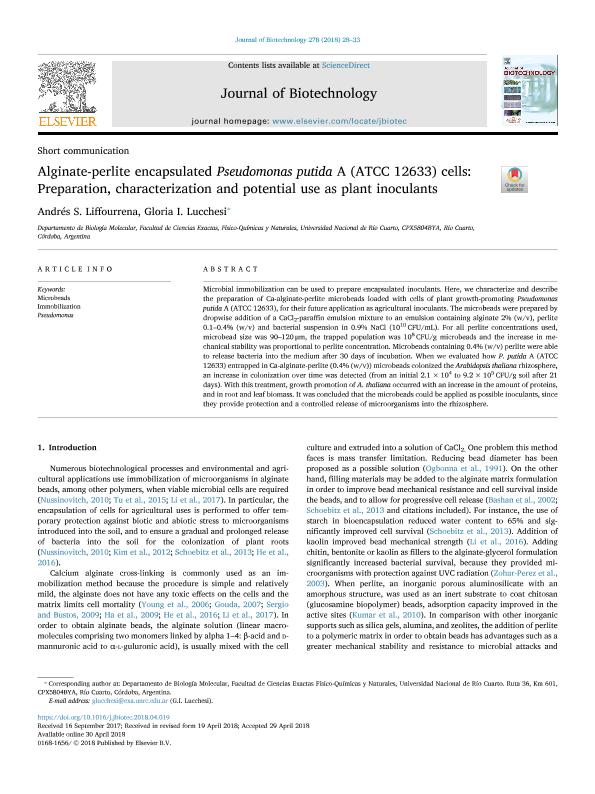Artículo
Alginate-perlite encapsulated Pseudomonas putida A (ATCC 12633) cells: Preparation, characterization and potential use as plant inoculants
Fecha de publicación:
20/07/2018
Editorial:
Elsevier Science
Revista:
Journal of Biotechnology
ISSN:
0168-1656
Idioma:
Inglés
Tipo de recurso:
Artículo publicado
Clasificación temática:
Resumen
Microbial immobilization can be used to prepare encapsulated inoculants. Here, we characterize and describe the preparation of Ca-alginate-perlite microbeads loaded with cells of plant growth-promoting Pseudomonas putida A (ATCC 12633), for their future application as agricultural inoculants. The microbeads were prepared by dropwise addition of a CaCl2-paraffin emulsion mixture to an emulsion containing alginate 2% (w/v), perlite 0.1–0.4% (w/v) and bacterial suspension in 0.9% NaCl (1010 CFU/mL). For all perlite concentrations used, microbead size was 90–120 μm, the trapped population was 108 CFU/g microbeads and the increase in mechanical stability was proportional to perlite concentration. Microbeads containing 0.4% (w/v) perlite were able to release bacteria into the medium after 30 days of incubation. When we evaluated how P. putida A (ATCC 12633) entrapped in Ca-alginate-perlite (0.4% (w/v)) microbeads colonized the Arabidopsis thaliana rhizosphere, an increase in colonization over time was detected (from an initial 2.1 × 104 to 9.2 × 105 CFU/g soil after 21 days). With this treatment, growth promotion of A. thaliana occurred with an increase in the amount of proteins, and in root and leaf biomass. It was concluded that the microbeads could be applied as possible inoculants, since they provide protection and a controlled release of microorganisms into the rhizosphere.
Palabras clave:
IMMOBILIZATION
,
MICROBEADS
,
PSEUDOMONAS
Archivos asociados
Licencia
Identificadores
Colecciones
Articulos(CCT - CORDOBA)
Articulos de CTRO.CIENTIFICO TECNOL.CONICET - CORDOBA
Articulos de CTRO.CIENTIFICO TECNOL.CONICET - CORDOBA
Citación
Liffourrena, Andres Sebastian; Lucchesi, Gloria Ines; Alginate-perlite encapsulated Pseudomonas putida A (ATCC 12633) cells: Preparation, characterization and potential use as plant inoculants; Elsevier Science; Journal of Biotechnology; 278; 20-7-2018; 28-33
Compartir
Altmétricas




